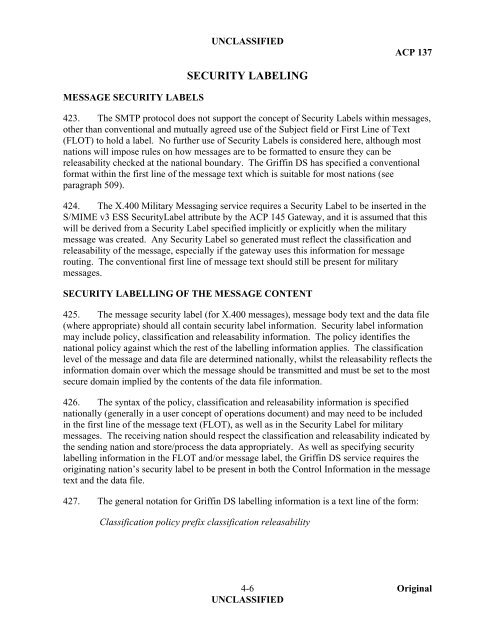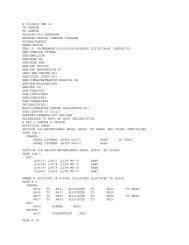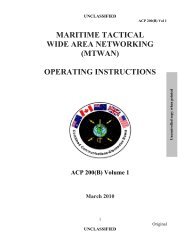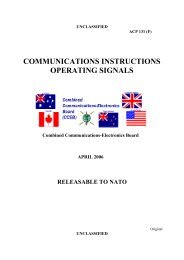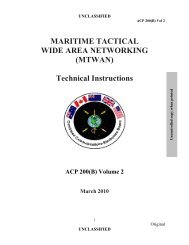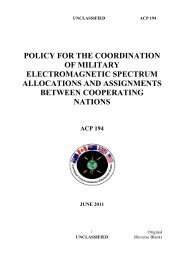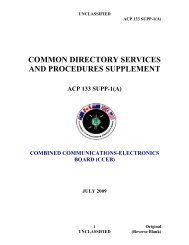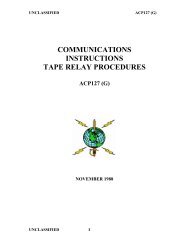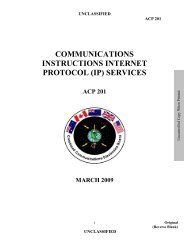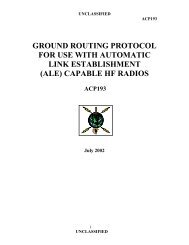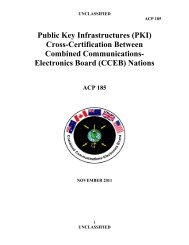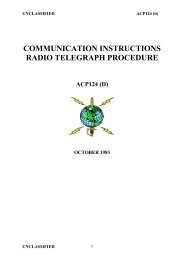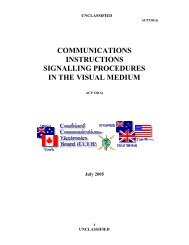ACP 137
ACP 137
ACP 137
You also want an ePaper? Increase the reach of your titles
YUMPU automatically turns print PDFs into web optimized ePapers that Google loves.
UNCLASSIFIED<br />
<strong>ACP</strong> <strong>137</strong><br />
MESSAGE SECURITY LABELS<br />
SECURITY LABELING<br />
423. The SMTP protocol does not support the concept of Security Labels within messages,<br />
other than conventional and mutually agreed use of the Subject field or First Line of Text<br />
(FLOT) to hold a label. No further use of Security Labels is considered here, although most<br />
nations will impose rules on how messages are to be formatted to ensure they can be<br />
releasability checked at the national boundary. The Griffin DS has specified a conventional<br />
format within the first line of the message text which is suitable for most nations (see<br />
paragraph 509).<br />
424. The X.400 Military Messaging service requires a Security Label to be inserted in the<br />
S/MIME v3 ESS SecurityLabel attribute by the <strong>ACP</strong> 145 Gateway, and it is assumed that this<br />
will be derived from a Security Label specified implicitly or explicitly when the military<br />
message was created. Any Security Label so generated must reflect the classification and<br />
releasability of the message, especially if the gateway uses this information for message<br />
routing. The conventional first line of message text should still be present for military<br />
messages.<br />
SECURITY LABELLING OF THE MESSAGE CONTENT<br />
425. The message security label (for X.400 messages), message body text and the data file<br />
(where appropriate) should all contain security label information. Security label information<br />
may include policy, classification and releasability information. The policy identifies the<br />
national policy against which the rest of the labelling information applies. The classification<br />
level of the message and data file are determined nationally, whilst the releasability reflects the<br />
information domain over which the message should be transmitted and must be set to the most<br />
secure domain implied by the contents of the data file information.<br />
426. The syntax of the policy, classification and releasability information is specified<br />
nationally (generally in a user concept of operations document) and may need to be included<br />
in the first line of the message text (FLOT), as well as in the Security Label for military<br />
messages. The receiving nation should respect the classification and releasability indicated by<br />
the sending nation and store/process the data appropriately. As well as specifying security<br />
labelling information in the FLOT and/or message label, the Griffin DS service requires the<br />
originating nation’s security label to be present in both the Control Information in the message<br />
text and the data file.<br />
427. The general notation for Griffin DS labelling information is a text line of the form:<br />
Classification policy prefix classification releasability<br />
4-6<br />
UNCLASSIFIED<br />
Original


